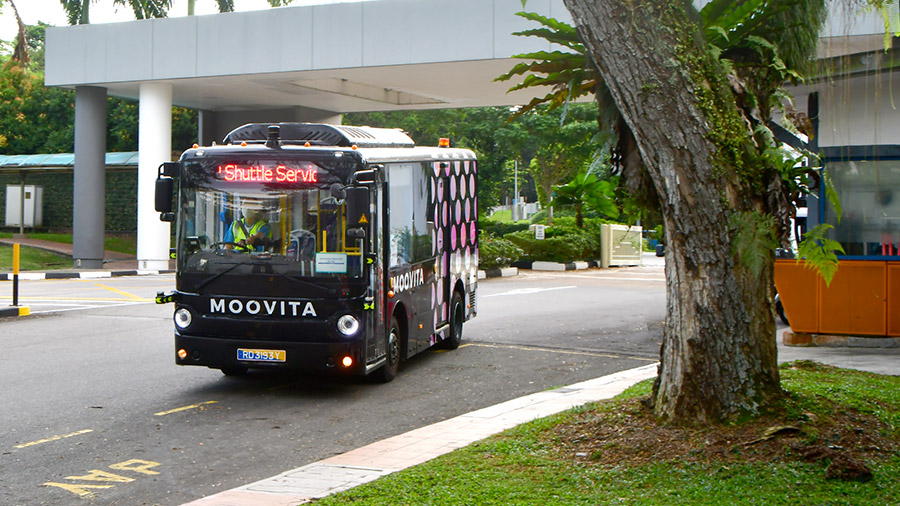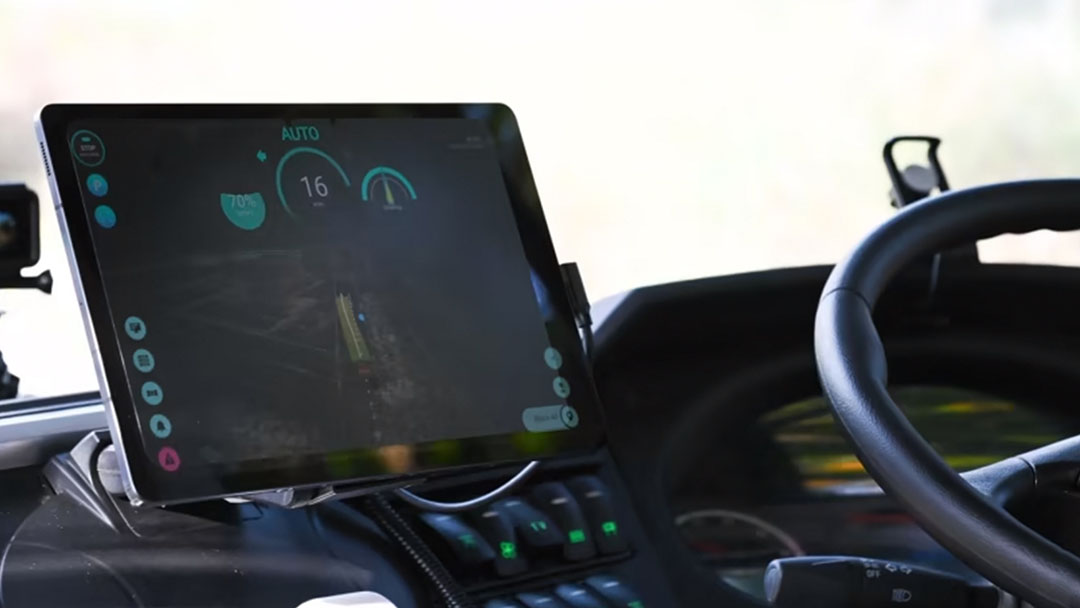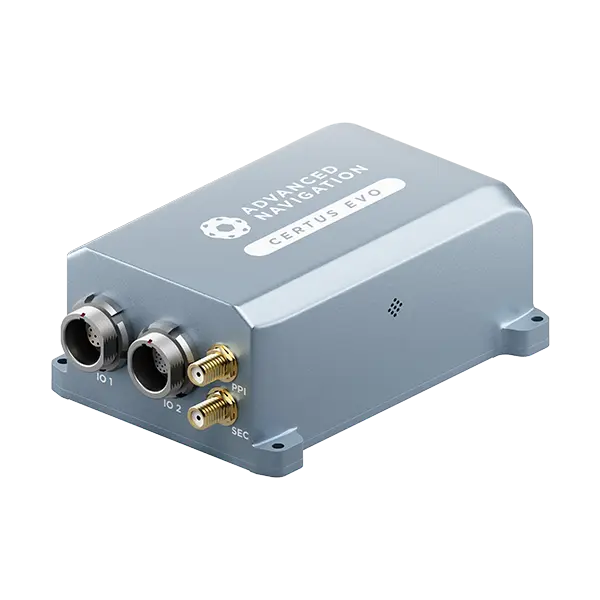Case Study


Published on:
Founded in 2016 by a group of scientists and engineers, MooVita has emerged as a global leader in autonomous vehicle technology. The company is currently conducting live pilots of its autonomous buses within controlled environments in Singapore, laying the groundwork for the future adoption of autonomous vehicles on public roads.
In the bustling city-state of Singapore, a revolution in public transport is in motion. MooVita, an innovative company born from a government research institute, is leading the charge with its autonomous buses to address rising concerns about the future of Singapore’s public transportation.
“These concerns stem from the city’s aging population in need of greater mobility and a dwindling interest among people wanting to be bus drivers due to changing expectations of the labour market.”
explains Ken Chan, Vice President of MooVita.
Combined with stringent government taxes that have long made private car ownership prohibitively expensive for most residents, this has created the perfect storm, driving the need to change the status quo and make public transport more cost-effective than ever.
As we enter the age of autonomy, autonomous buses have quickly emerged as an alternative to traditional methods, including crewed buses and taxis. Their capability to transport large numbers of passengers fully autonomously makes them a highly promising solution.
As a leading manufacturer of autonomous vehicles, MooVita harbors a grand vision to provide stress-free rides for people who require mobility services and to reduce the number of vehicles on the road.
Encouragingly, there has been remarkable industry enthusiasm for autonomous transportation worldwide, with numerous projects underway to set up the future for adoption. The following case study delves into MooVita’s progress and the pivotal role played by Advanced Navigation’s Certus Evo INS in getting these vehicles ready for public testing in controlled environments.
To successfully deploy autonomous vehicles for civilian use, the seamless integration and reliability of navigation systems are critical. While there has been considerable progress in these technological areas, navigating the regulatory landscape has been more challenging than expected. These technologies must go through strict, frequent testing, validation and refinement, before becoming widely accepted by both the public and regulatory bodies, and eventually ready for deployment on roads.
Autonomous vehicles, including MooVita’s buses, depend on a comprehensive suite of sensors for safe and effective operation. These include cameras, radars and preloaded high-definition maps. The maps serve as a digital blueprint of the environment, encompassing information on routes, landmarks, traffic lanes, pedestrian crossings — and even the precise locations and the height of curbs.
According to Chan, the autonomous vehicle system on each MooVita bus incorporates 16 sensors integrated with advanced algorithms to deliver a continuous 360-degree view around the vehicle.
“The system also features dynamic object recognition and collision avoidance, crucial for the safe interaction with its environment.”
“An INS is essential for maintaining safety and meeting regulatory compliance.”
Ken Chan
Among these systems, Chan specifically highlights the importance of having a reliable inertial navigation system (INS). This ensures the bus always knows its position in environments where GNSS reliability is compromised, most notably in urban areas.
Inertial navigation systems (INS) have proven to be especially useful in urban environments, where skyscrapers and tunnels can block the view of the sky and disrupt GNSS signals. These systems are also invaluable when buses experience harsh weather conditions, such as medium to heavy rainfall, snow or fog, resultantly compromising GNSS reliability.
For MooVita’s autonomous bus fleet, the company’s engineers selected Advanced Navigation’s Certus Evo, an ultra-high accuracy MEMS GNSS/INS capable of providing extremely accurate position, velocity, acceleration, and orientation under the most demanding conditions.
After testing and evaluating various INS’s from different manufacturers, MooVita’s team selected Advanced Navigation’s Certus Evo, an ultra-high accuracy MEMS GNSS/INS. Certus Evo provides near-FOG performance, enabling extremely accurate position, velocity, acceleration, and orientation under the most demanding conditions.
“Our product team conducted trials with several units and found that Certus Evo consistently lived up to its specs while demonstrating a lower error rate compared to other models.”
Ken Chan
Upon rigorous testing, Certus Evo demonstrated superior performance by providing more accurate reading and positioning data, as well as minimal drift, compared with competing products.
As a supporting system to the vehicle’s primary sensor array, Certus Evo ensures MooVita’s buses maintain reliable positioning even in the most demanding conditions, including within urban areas with tall buildings, during heavy rainfall and on roads with unique and complex features. This is a critical capability for maintaining MooVita systems’ overall reliability.
All of this is built into an efficient package with optimized size and weight. Although less crucial for heavy vehicles such as autonomous buses, these factors will be able to deliver significant versatility and cost savings for other platforms MooVita may explore in the future, such as smaller robots, drones and automated guided vehicles (AGVs).

Steering autonomous vehicles towards mainstream adoption depends on more than technological breakthroughs. It also necessitates meeting stringent international road safety and cybersecurity standards, specifically ISO 26262 for autonomous vehicles and ISO 21434 for cybersecurity. This compliance is crucial for ensuring the safety of all road users and is a key prerequisite to qualify autonomous vehicles onto public roads.
Acknowledging the critical importance of safety, MooVita has embarked on an extensive process of testing and validation to align with Singapore’s rigorous road safety regulations for autonomous vehicles. Under Chan’s leadership, MooVita has launched two significant live pilots to showcase the practicality and safety of their autonomous buses. These demonstrations are currently limited to controlled environments, such as private roads, business parks, airports and campuses, with prospects to be rolled out onto public roads in the future.
“The ongoing success of these pilots will be instrumental in obtaining regulatory approval and building public confidence.”
Ken Chan
In their first commercial trial, MooVita introduced the MooBus minibus, which navigates a 3-kilometer route between ten locations across Ngee Ann Polytechnic, making stops along the way. The service operates during peak hours according to a fixed schedule and is regulated by safety protocols requiring an onboard safety operator. The trial serves as both a demonstration of MooVita’s technology and an ongoing service enhancing campus mobility.
Expanding beyond the polytechnic, MooVita has initiated an additional trial at one of Singapore’s major security facilities. Unlike the service at Ngee Ann Polytechnic, this trial offers both a scheduled service at peak times and as an on-demand service. Programmed with high-definition maps for autonomous navigation, the buses at the facilities also allow human operators to take control, ensuring a seamless integration of autonomy and human supervision.
“While we strive for full automation and allow the vehicles to drive as autonomously as possible, regulations require onboard operators ready to address unforeseen challenges.”
Ken Chan
Through these live trials in controlled environments, MooVita is setting the stage for the next phase of their business plan, which is to validate their proof of value.

Singapore’s efforts to revolutionize public transportation with autonomous vehicles are not unique. With increasing urbanizaton and growing populations, governments around the world are seeking transportation solutions to enhance mobility, and make public transport easy and efficient.
According to Global Market Insights, the autonomous bus market was valued at USD 1.7 billion worldwide in 2022, with expectations for significant expansion at a compound annual growth rate (CAGR) of 19.7% from 2023 to 2032. This demand is particularly pronounced in Asia, where capital cities are densely populated.
Recognizing this immense growth potential, MooVita’s ambitions extend well beyond its home base in Singapore. “We’ve started dialogue with authorities and organizations in China, Malaysia, Japan, Korea, and the Middle East to introduce our autonomous vehicle kits to these markets,” Chan reveals.
“We’ve started dialogue with authorities and organizations in China, Malaysia, Japan, Korea, and the Middle East to introduce our autonomous vehicle kits to these markets.”
reveals Ken Chan
“Our aim isn’t just to develop buses but also to kick-off the commercial production of autonomous vehicle kits for OEM suppliers.” he
Adds Ken Chan, pointing to a future where vehicle manufacturing will align seamlessly with autonomous technology.
Chan is also optimistic about the timeline for mainstream adoption. He anticipates that within five years, autonomous vehicle technology will be widely accepted in controlled environments, eventually making its way to public roads at low speed, starting in urban centers before moving to other areas.
No doubt, the vision for autonomous buses and public transport is a compelling one. It is one marked by cities with reduced traffic congestion and emissions — a place where public transport has transited from a necessity to a preferred choice. However the world gets there, the journey promises to be an exciting ride for everyone on board.

Certus Evo is an AI-based MEMS GNSS-aided INS that provides extremely accurate position, velocity, acceleration and orientation under the most demanding conditions. It offers FOG-like performance combined with the reliability and affordability of MEMS sensors. It features low SWaP-C (Size, Weight, Power, and Cost), internal data logging, and multiple communication interfaces for easy integration. Certus Evo is available in both OEM and rugged packages and comes standard with licence-free 1 cm RTK position accuracy.